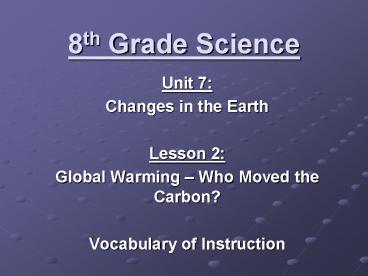8th Grade Science - PowerPoint PPT Presentation
1 / 20
Title:
8th Grade Science
Description:
8th Grade Science Unit 7: Changes in the Earth Lesson 2: Global Warming Who Moved the Carbon? Vocabulary of Instruction 1. Acid Rain Rain that has a pH lower than ... – PowerPoint PPT presentation
Number of Views:97
Avg rating:3.0/5.0
Title: 8th Grade Science
1
8th Grade Science
- Unit 7
- Changes in the Earth
- Lesson 2
- Global Warming Who Moved the Carbon?
- Vocabulary of Instruction
2
1. Acid Rain
- Rain that has a pH lower than 7 because it
contains nitric and sulfuric acids and other air
pollutants dissolved in it.
3
2. Emissions
- Substances discharged into the air, especially by
internal combustion engines (airplanes, cars, and
factories) due to the burning of fossil fuels.
4
Yearly increase of atmospheric CO2. In the
1960s, the average annual increase was 37 the
2000-2007 average.
5
Main symptoms of Carbon Dioxide toxicity in Humans
6
3. Equilibrium
- State of natural balance within a community of
organisms in which ecosystem diversity remain
relatively stable. - In some environments, succession reaches a
climax, producing a stable community dominated by
a small number of prominent species.
7
Aquatic Ecosystem (Food Web) in Equilibrium
8
(1) a climax forest (2) destroyed by wildfire and
(3 and 4) its eventual recovery. Secondary
succession occurs in an area where life once
existed but has then been destroyed.
9
4. Fertilizer Runoff
- Fertilizers include natural (animal manure) and
synthetic materials (nitrogen, phosphorus, and
potassium compounds) that are spread on or worked
into soil to increase its capacity to support
plant growth. - Runoff of soil and fertilizer is common during a
rain storm which end up in rivers, lakes, and
oceans.
10
Old and Modern Fertilizer Spreader
11
Decomposing animal manure, an organic fertilizer
source
12
5. Global Warming
- The increase of greenhouse gas concentration
(mainly carbon dioxide) that led to a substantial
warming (increase in the average atmospheric
temperature) of the earth and the sea that causes
corresponding changes in the climate.
13
Average Temperature Increase
14
From which sectors do the major greenhouse gas
emissions come from? The lower part of the
picture shows the sources individually for the
gases carbon dioxide, methane and nitrous oxide,
respectively.
15
6. Greenhouse Effect
- The greenhouse effect is caused by an atmosphere
containing gases that absorb and emit infrared
heat radiation, due to its absorption by
atmospheric carbon dioxide, water vapor, methane,
and other gases.
16
Real Greenhouses used to grow plants under
controlled conditions
17
7. Ozone Depletion
- The destruction of the protective layer of ozone
in the upper atmosphere by chemical pollution. It
is attributed to the presence of chlorine from
manmade Chlorofluorocarbons (CFCs) and other
forces. The layer is thinning because ozone is
being destroyed at a faster rate than it is being
regenerated by natural forces.
18
Ozone Depletion Causes and Effects
- The blue and purple colors are where there is the
least ozone, and the greens, yellows, and reds
are where there is more ozone.
19
(No Transcript)
20
Ozone Depletion Effects































